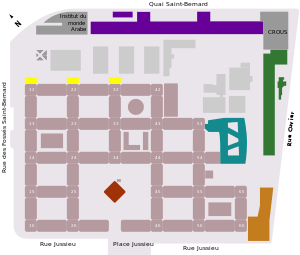Jussieu Campus
The Jussieu Campus (Campus Universitaire de Jussieu) is a higher education campus located in the 5th arrondissement of Paris, France. It is the main campus of the Faculty of Science of Sorbonne University. The Paris Diderot University (Paris VII), was also originally located on the Jussieu campus but moved to its new independent campus in the Paris Rive Gauche neighborhood in 2006-2012. Many ties continue to exist between the two universities.
Because of reconstruction programs in progress (see below), various facilities have been moved out of the campus to other parts of Paris.
History
The campus was opened in 1951 and eventually it would host a great part of the old faculty of sciences of the Sorbonne. Built on the site of the old "Halle aux vins," a wine market created by Napoleon Bonaparte, the campus remains incomplete to this day. In 1957, the first university buildings were built along the Eastern bank of the River Seine (le quai Saint-Bernard), and Rue Cuvier. In order to allow the wine?unclear to remain on the site, the architects planned to construct the buildings on stilts above the roads of the market.
However, in 1964, with over 20,000 science students graduating high school (the baby boom generation), the old Sorbonne could not accommodate the influx of students. Cultural minister André Malraux entrusted the architect Édouard Albert with the task of rapidly constructing a new science campus on the site. Albert's grand vision of modular metallic buildings, designed to facilitate interdisciplinary work and improve teaching, was never achieved, and eventually abandoned in 1972.
Facilities

Most of the campus consists in a regular grid of 6-floor wings; at the points of intersection are staircases and elevators. The grid is built on a large elevated slab, and the wings do not reach to the bottom of the slab, making it possible to walk across the campus without entering the buildings. Underneath the slab are ground-level and underground facilities, including a car park. The main front of Jussieu is bounded by a 10 meter deep dry moat, and many pedestrian entrances are bridges over this moat that can be readily secured. The high security features of the campus are likely a response to the student riots that occurred in 1968 in this neighborhood.
In the center of the campus is the Tour Zamansky, or Tour Jussieu, with 24 floors and a height of 90 meters, used for administrative purposes. Certain research libraries (in mathematics, for instance) are among the largest and with the widest selection of books in France. Campus restaurants are located in the northeast corner of the campus, many of which afford a pleasant view of the Seine River.
Controversies and asbestos

The campus was often decried as an architectural failure. The hollow space under the building wings enables wind to build up its force, and thus the environment on the slab is unfriendly. Sound-proofing is very poor, with classes regularly having to briefly stop when someone flushes the toilet next door. The regular grid plan is confusing, and only long-time residents can move through without going back to the wind-blown ground level, since many corridors do not allow through-crossing (laboratories etc. have often chosen to lock their corridor for safety reasons). The campus had increasingly deteriorated since its construction, and its older tower stairwells and exteriors were covered in perpetual graffiti.
The most worrisome aspect of the Jussieu architecture was its extensive use of asbestos as a fire retardant. Asbestos fibers are carcinogenic when inhaled. As a consequence, the use of asbestos in buildings is prohibited in France, but was not at the time when the campus was built. The risks are particularly acute for workers who maintain the building (drilling walls, for example). In addition, the fire retardation is not considered sufficient, so that its metal frames would collapse in a large fire. An ambitious clean-up program was begun in 1997 after some high-profile protests. The wings are stripped of all equipment, walls, etc., down to the naked concrete frame, and are then rebuilt using more modern materials. Many advocated the destruction of Jussieu when the asbestos problem was addressed. However, the campus is protected as an architectural type, and must be restored to its original condition.
In 1996 Claude Allègre, a well known French politician and former scientist, opposed the removal of asbestos from the campus, describing it as harmless and dismissing concerns about it as a form of "psychosis created by leftists".[1] The campus' asbestos is deemed to have killed 22 people and caused serious health problems in 130 others.[2]
The 1997–2016 refurbishment completely removed the asbestos. This was also an opportunity to rebuild the campus to be more friendly to its inhabitants. The graffiti were removed; sound proofing and thermal isolation was added; many of the depressing round stairwells were replaced by straight ones; openings were made to create vistas and let in light; the prefabs were destroyed and replaced by gardens; courtyards were covered by transparent roofing; a dry garden was created around the Zamansky building; and a restaurant was opened in the South-East courtyard.
Transportation
The campus is served by the Paris Métro station Jussieu, as well as numerous bus lines.
References
- "Claude Allègre: Qui a peur du 'serial gaffeur'?", Marianne, May 30, 2009, p.48
- "Déjà 22 morts et 130 malades: Les amiantes de jussieu", Nouvel Observateur, November 29, 2007
External links
| Wikimedia Commons has media related to Campus universitaire de Jussieu. |
- Sites historiques: Campus Jussieu (in French)
- HISTORIQUE DU CAMPUS JUSSIEU (in French)